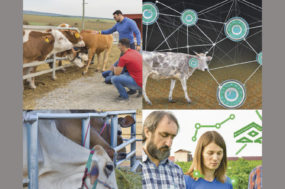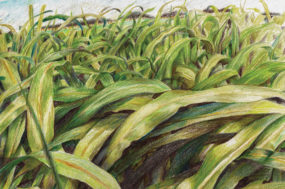Now all of that was before my time, but Moses sure seemed to have been onto something, especially for those of us involved with agriculture.
Some good news on this front though, stems from the fact that grasses native to the central and eastern U.S. (things like switchgrass, big bluestem, indiangrass, etc.) do not have many serious pests. Not that they don’t have pests, mind you – some 80-odd species of fungus alone have been identified just on switchgrass.
But mercifully – and perhaps because of their adaption to the region – most of these pests do not seem to be particularly troublesome.
Too, it seems a number of the pests appear to be more of an issue in the northern part of the range of these grasses. That might only be because folks in states like Iowa and the Dakotas may have looked for these things more than what we have in the Southern Plains or Southeast.
Rust: It doesn’t just appear on your equipment
Probably the most obvious pest we have dealt with here in Tennessee and the surrounding states, is rust (Figures 1 and 2).
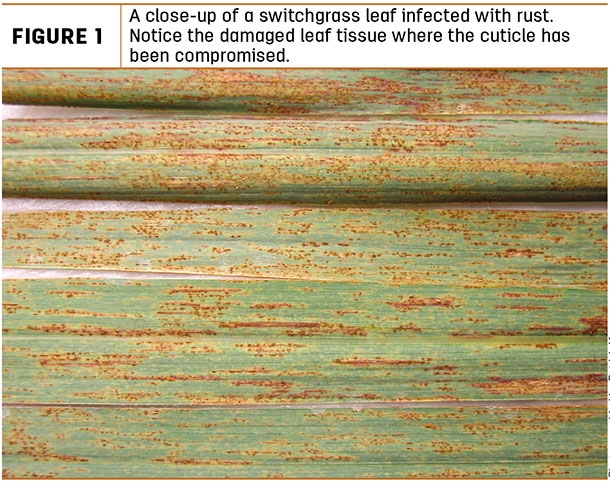
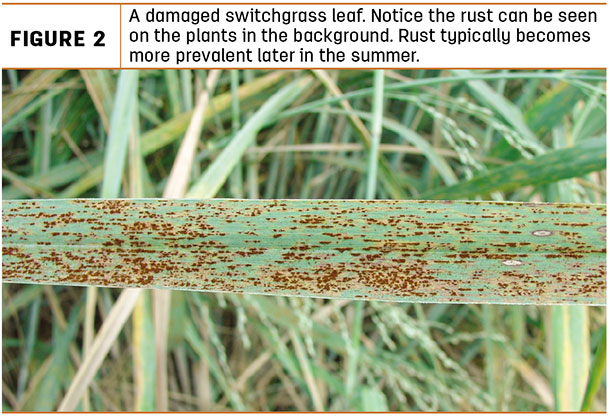
Rust is a fungus, and various species of this pest afflict all sorts of important crops – small grains in particular. Like the other native grasses mentioned above, eastern gamagrass can also be susceptible to rust (Figure 3).
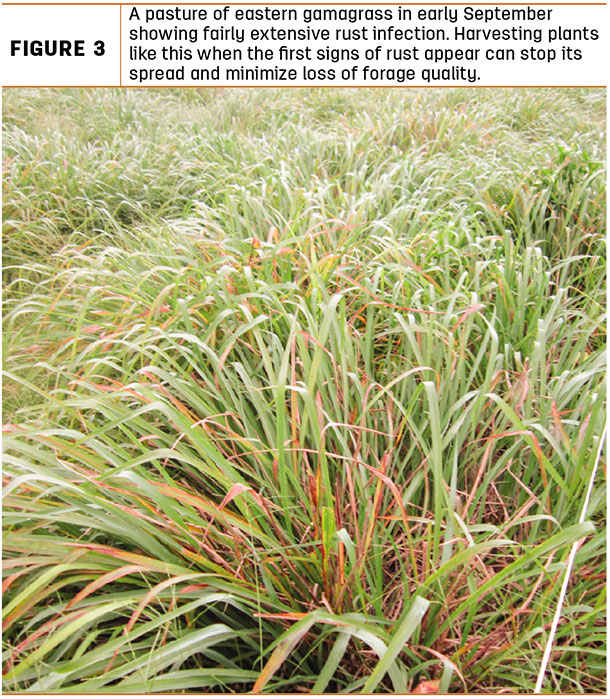 Unfortunately, little is known about how the life cycle of rust on switchgrass (or other native grasses) actually works. Typically, there is an alternate host, but with the genus puccinia (the rust on switchgrass), we have not been able to confirm that cycle.
Unfortunately, little is known about how the life cycle of rust on switchgrass (or other native grasses) actually works. Typically, there is an alternate host, but with the genus puccinia (the rust on switchgrass), we have not been able to confirm that cycle.
Furthermore, rust does not overwinter in our stands. The best we know at this point, is the fungus overwinters in stands further south where plants can remain photosynthetically active. In the spring, the disease advances northward as spores blow in with southerly winds.
So what can we do about rust? First, we cannot stop its spread or influence its distribution. Warm, humid conditions are conducive to infection and cool, dry conditions tend to retard its spread. The only management option we have is to catch an infection of a pasture (or hayfield) early on and harvest the stand as a hay crop. Simply clipping infected plants can work as well.
Once the infected leaf area has been cut, the rust will die – since it requires living tissue as a host. Because of the timing of infections, prescribed burning, which is commonly used to manage native grasses, would not provide any benefit.
Plants infected with rust will experience reduced yield and reduced forage quality, but do not otherwise impact grazing animals. Hay made from infected leaves can be fed without any negative health implications – it will simply be a lower-quality hay because of the damage to those leaves.
Smut: It’s as dirty looking as it sounds
Another important switchgrass pest documented in Iowa is smut (Tilletia maclaganii). It has also been documented in North Carolina (Figure 4).
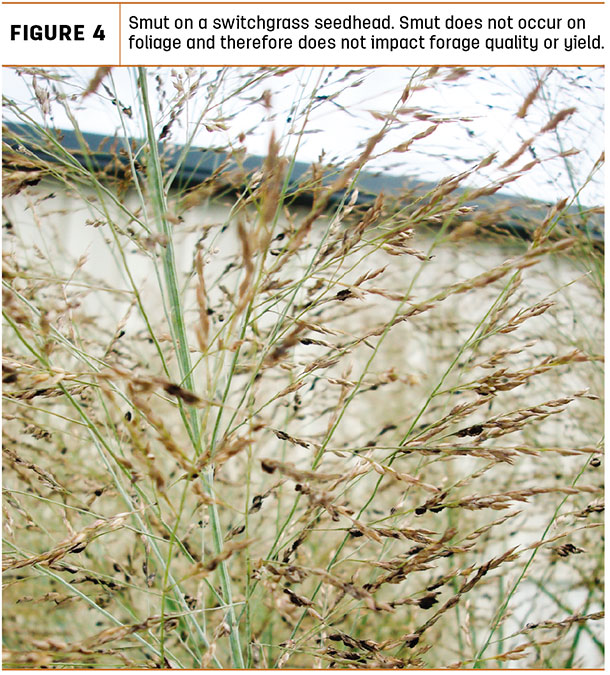
However, smut affects only the inflorescence and does not have an impact on plant yield or forage quality. For seed growers though, it can be a serious problem. Big bluestem also is susceptible to some smuts. Here in east Tennessee, we have also seen the fungus “take-all root rot” on eastern gamagrass.
It has not lead to any mortality that we are aware of, but certainly has stressed individual plants and clearly reduced their yield and forage quality (Figure 5).
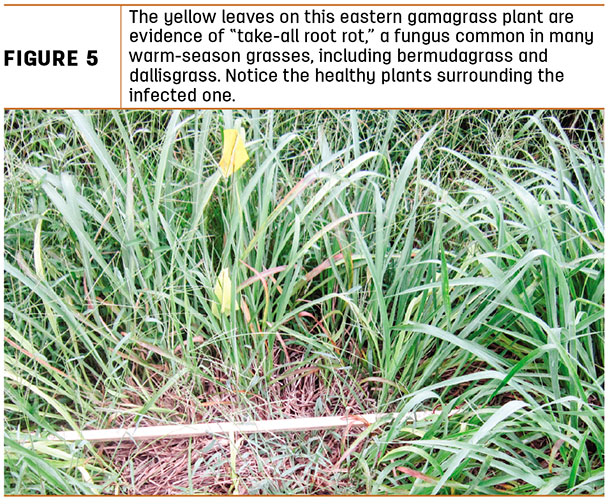
Viral diseases have also been documented in switchgrass and eastern gamagrass but to our knowledge, are not common.
Although many insects occur in native grass stands, there have been few documented cases of serious crop loss. We have seen substantial damage to switchgrass seedlings (typically in the four-leaf stage or smaller plants) as a result of Colorado potato beetles.
This seems to be most common where horse nettle is found in pastures being converted to native grasses. With reduced populations of host plants, the beetles will often feed heavily on these small seedlings, leading to seedling mortality.
Taken all together, there are some disease and pest issues to be aware of for native grasses, but they are not common – with the exception of rust. In most cases, there is little we can do, and we simply have to live with them. ![]()
PHOTO 1: A close-up of a switchgrass leaf infected with rust. Notice the damaged leaf tissue where the cuticle has been compromised.
PHOTO 2: A damaged switchgrass leaf. Notice the rust can be seen on the plants in the background. Rust typically becomes more prevalent later in the summer.
PHOTO 3: A pasture of eastern gamagrass in early September showing fairly extensive rust infection. Harvesting plants like this when the first signs of rust appear can stop its spread and minimize loss of forage quality.
PHOTO 4: Smut on a switchgrass seedhead. Smut does not occur on foliage and therefore does not impact forage quality or yield.
PHOTO 5: The yellow leaves on this eastern gamagrass plant are evidence of “take-all root rot,” a fungus common in many warm-season grasses, including bermudagrass and dallisgrass. Notice the healthy plants surrounding the infected one. Photos provided by Patrick Keyser.
David McIntosh is the coordinator for the University of Tennessee Beef and Forage Center. Denita Guerry is a research assistant professor in the University of Tennessee Department of Entomology and Plant Pathology.

-
Patrick Keyser
- professor and director of the Center for Native Grasslands Management
- University of Tennessee Institute of Agriculture
- Email Patrick Keyser


